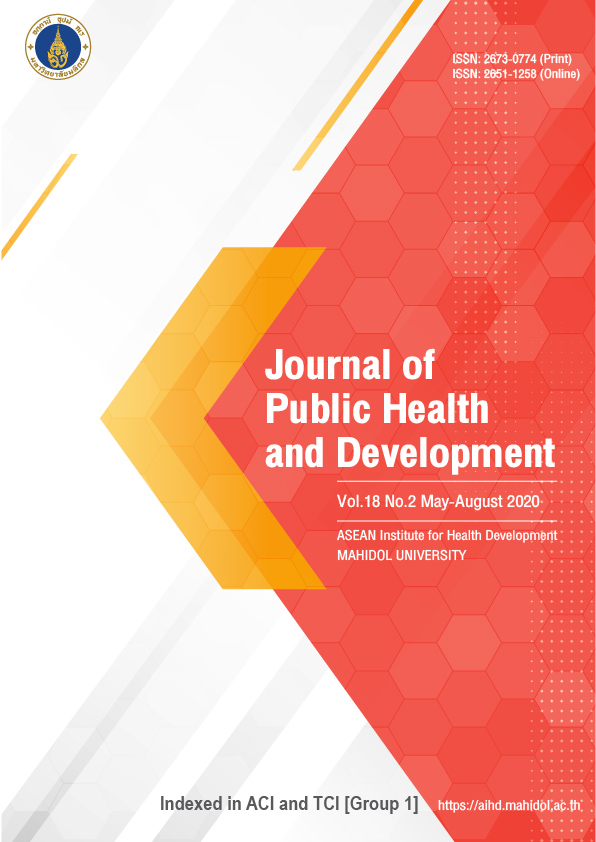Community-Based Health Literacy Program on Uncontrolled Hypertension in Urban Area, Thailand
Main Article Content
Abstract
Many strategies have been used to address uncontrolled HT. This study aimed to determine the community-based health literacy program which effected on uncontrolled hypertension (HT) in an urban area. This was a quasi-experiment performing during June 2017 to March 2018. Two urban areas were selected as sites for an intervention group and a comparison group, and patients with uncontrolled HT were separately randomized within each group. The intervention group, consisting of 63 patients, received a community-based health literacy program of care for six months, and the comparison group, consisting of 60 patients, received usual care. Data were collected by questionnaire, and blood pressure (BP) measurement was done at home for seven consecutive days at baseline, three months, and six months. Biochemistry levels were tested at baseline and six months. Statistics were analyzed by descriptive statistics. Fisher’s exact and chi-square test was analyzed for categorical variables. Wilcoxon-Mann-Whitney test and independent-t test was analyzed for continuous variables. Multiple linear regression was used for mean comparison with adjusted confounders. Statistically significant changes (P < 0.001) were found between the intervention and comparison groups. The intervention group showed decrease of -9.6 mmHg (95% CI; -14.0, -5.2) in systolic home blood pressure (SHBP), -6.2 mmHg (95% CI; -8.2, -4.0) in diastolic home blood pressure (DHBP), -0.8 kg/ m2 (95% CI; -1.2, -0.4) in body mass index (BMI), and -23.8 mg/dL (95% CI; -34.2, -13.5) in low density lipoprotein (LDL) compared to the comparison group. The community-based health literacy program effectively decreased blood pressure, BMI and LDL in uncontrolled HT patients in an urban community. Expanding the program into other urban areas may be useful for HT control and prevent its complications.
Article Details
References
Organization WH. Global status report on noncommunicable diseases 2014. Geneva,Switzerland: World Health Organization; 2014.
Organization WH. Global Health Estimates (GHE) Geneva, Switzerland: World Health Organization; 2000-2012 [Available from: http://www.who.int/healthinfo/global_burden_disease/en/.
Aekplakorn W, Abbott-Klafter J, Khonputsa P, Tatsanavivat P, Chongsuvivatwong V, Chariyalertsak S, et al. Prevalence and management of prehypertension and hypertension by geographic regions of Thailand: the Third National Health Examination Survey, 2004. Journal of hypertension. 2008;26(2):191-8.
Organization WH. Noncommunicable diseases in the South-East Asia Region, 2011: situation and response. 2012.
Ministry of Public health. Literature Review: The Current Situation and Care Model of Non-Communicable Diseases Bangkok Thailand,: Bureau of medical technical and academic affair 2014.
Ministry of Social Development and Human Security. The important cause specific death rate in Thailand Ministry of Social Development and Human Security; 2014 [Available from: https://www.m-society.go.th/article_attach/15737/18923.pdf.
Kunnathum J, Makka N, Aungkulanon S, Amornvisaisoradej C, Bundhamcharoen K. A comparative risk assessment of health burden attributable to modifiable risk factors in Thailand, 2009: a systematic analysis. The Lancet. 2013;381:S78.
Alam MG, Barri YM. Systolic blood pressure is the main etiology for poorly controlled hypertension. American journal of hypertension. 2003;16(2):140-3.
Glynn LG, Murphy AW, Smith SM, Schroeder K, Fahey T. Interventions used to improve control of blood pressure in patients with hypertension. Cochrane database of systematic reviews. 2010(3).
Koh HK, Brach C, Harris LM, Parchman ML. A proposed ‘health literate care model’would constitute a systems approach to improving patients’ engagement in care. Health Affairs. 2013;32(2):357-67.
Ryan P, Sawin KJ. The individual and family self-management theory: Background and perspectives on context, process, and outcomes. Nursing outlook. 2009;57(4):217-25. e6.
Chow S-C, Shao J, Wang H, Lokhnygina Y. Sample size calculations in clinical research: Chapman and Hall/CRC; 2017.
Petsirasan R, Jirapaet V, Sasat S, Praditsuwan R. Effects of a Multicomponent Proactive Nursing Program on Blood Pressure Control at a 6-Month Follow-Up among Hypertensive Older Persons in Community. Journal of Health Research. 2012;26(5):227-33.
Schapira MM, Fletcher KE, Hayes A, Eastwood D, Patterson L, Ertl K, et al. The development and validation of the hypertension evaluation of lifestyle and management knowledge scale. The Journal of Clinical Hypertension. 2012;14(7):461-6.
Dhurakij Pundit University Research service center. Health Literacy Survey in Sample Population for Validity Testing by Psychometric Method
Bangkok Thailand,; 2013.
Han H-R, Lee H, Commodore-Mensah Y, Kim M. Development and validation of the hypertension self-care profile: a practical tool to measure hypertension self-care. The Journal of cardiovascular nursing. 2014;29(3):E11.
Fortuna RJ, Nagel AK, Rose E, McCann R, Teeters JC, Quigley DD, et al. Effectiveness of a multidisciplinary intervention to improve hypertension control in an urban underserved practice. Journal of the American Society of Hypertension. 2015;9(12):966-74.
Gwadry-Sridhar FH, Manias E, Lal L, Salas M, Hughes DA, Ratzki-Leewing A, et al. Impact of interventions on medication adherence and blood pressure control in patients with essential hypertension: a systematic review by the ISPOR medication adherence and persistence special interest group. Value in Health. 2013;16(5):863-71.
Carter BL, Rogers M, Daly J, Zheng S, James PA, Oparil S, et al. The Potency of Team-based Care Interventions for Hypertension. Arch Intern Med.169(19):1748-55.
Park E, Kim J. The Impact of a Nurse‐Led Home Visitation Program on Hypertension Self‐Management among Older Community‐Dwelling Koreans. Public Health Nursing. 2016;33(1):42-52.
Cooper LA, Roter DL, Carson KA, Bone LR, Larson SM, Miller ER, et al. A randomized trial to improve patient-centered care and hypertension control in underserved primary care patients. Journal of general internal medicine. 2011;26(11):1297-304.
He J, Irazola V, Mills KT, Poggio R, Beratarrechea A, Dolan J, et al. Effect of a community health worker–led multicomponent intervention on blood pressure control in low-income patients in Argentina: a randomized clinical trial. Jama. 2017;318(11):1016-25.
Tucker KL, Sheppard JP, Stevens R, Bosworth HB, Bove A, Bray EP, et al. Self-monitoring of blood pressure in hypertension: a systematic review and individual patient data meta-analysis. PLoS medicine. 2017;14(9):e1002389.
Stergiou GS, Bliziotis IA. Home blood pressure monitoring in the diagnosis and treatment of hypertension: a systematic review. American journal of hypertension. 2011;24(2):123-34.


